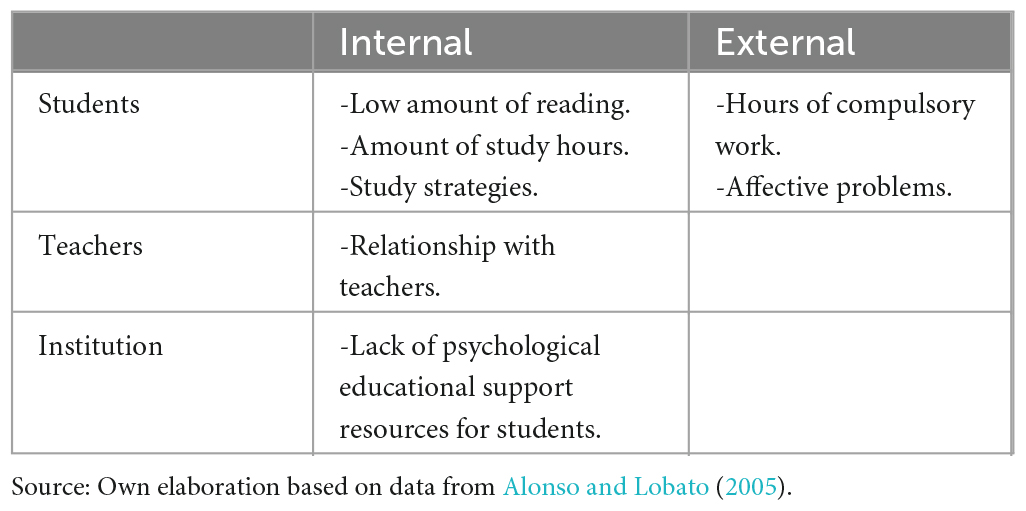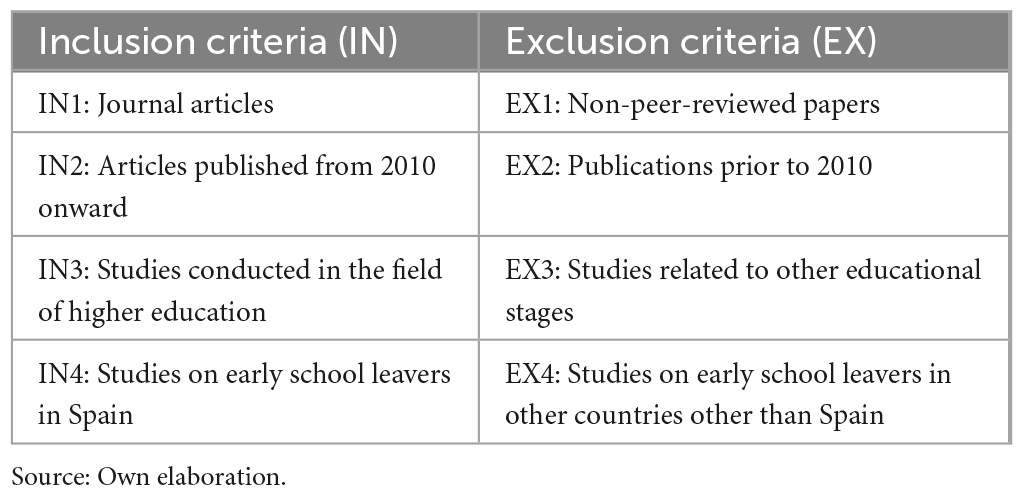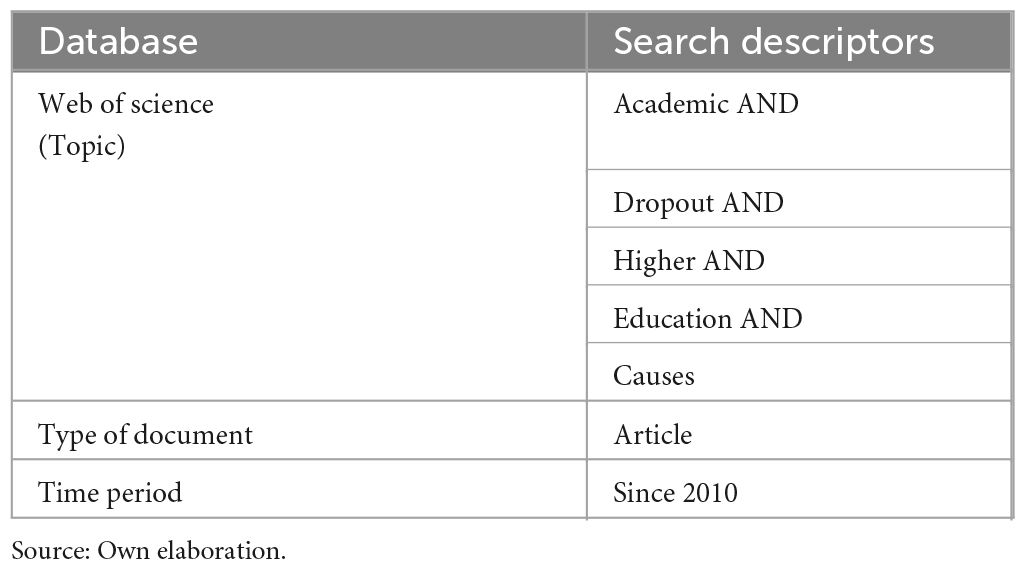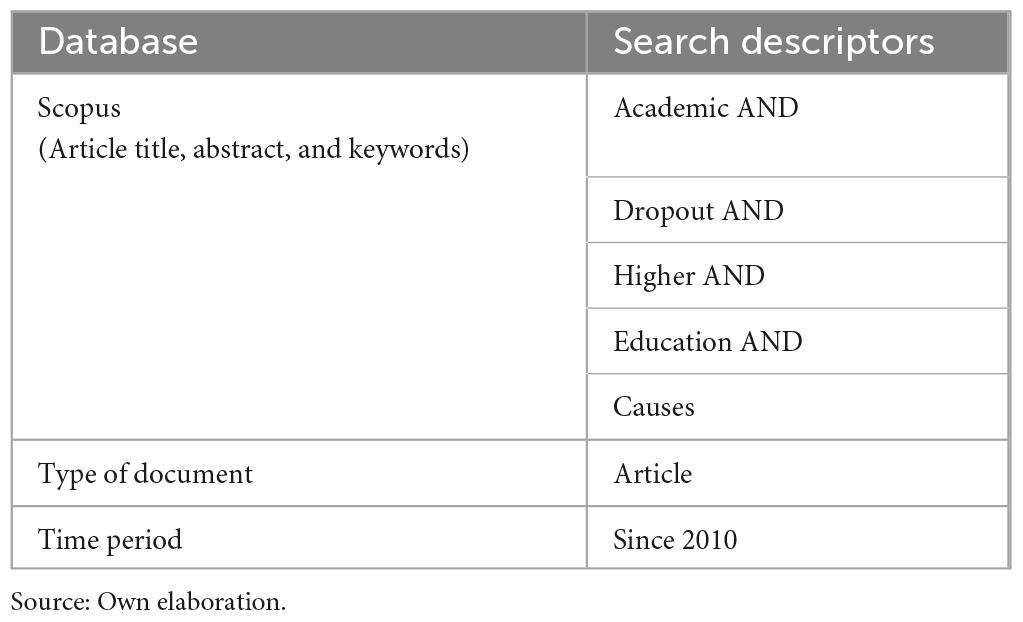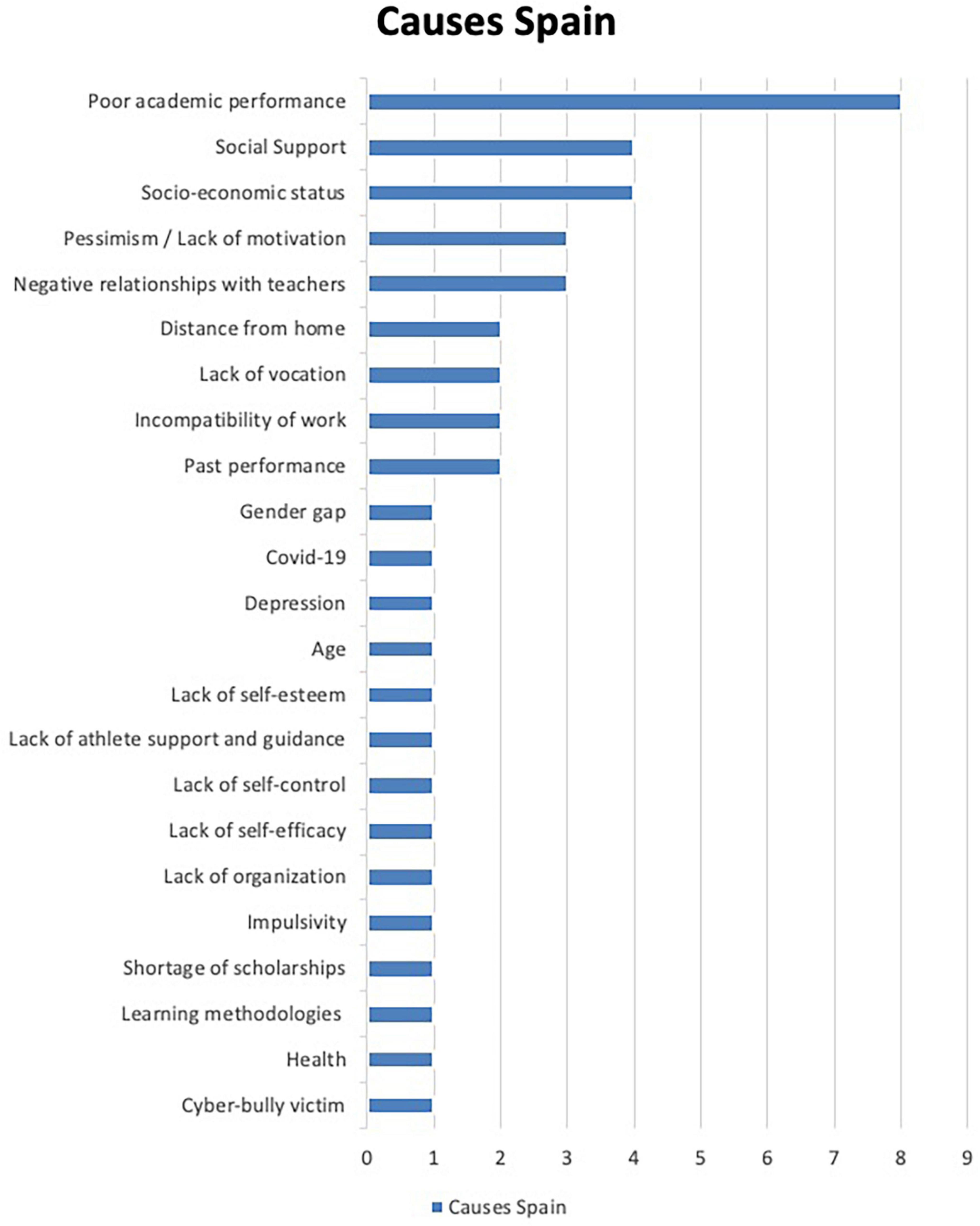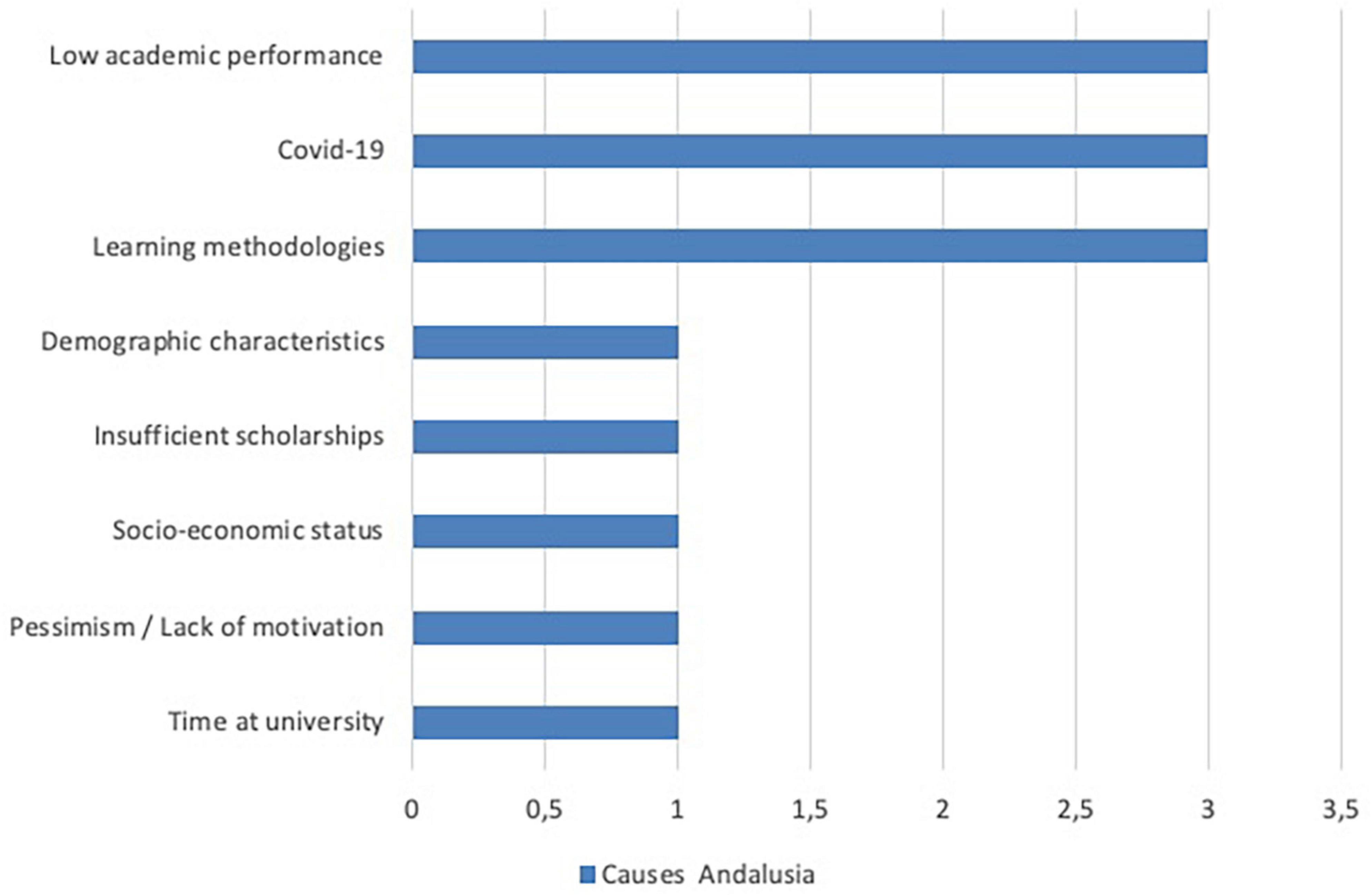Causes of academic dropout in higher education in Andalusia and proposals for its prevention at university: A systematic review
- 1Department of Didactics and School Organization, Faculty of Education and Sport Sciences of Melilla, University Campus of Melilla, University of Granada, Melilla, Spain
- 2Department of Didactics and School Organization, Faculty of Education Sciences, University Campus of Cartuja, University of Granada, Granada, Spain
Introduction: One of the main problems facing the university system is the high student dropout rate due to a number of variables, accentuated by the COVID-19 pandemic. This is a problem not only in Spanish universities but is prevalent worldwide. It is therefore important to understand and analyze the underlying reasons for dropout so that it can be addressed and mechanisms implemented to limit dropout in higher education to the greatest extent possible.
Method: A systematic review was carried out summarizing the results of studies and reports on university dropout in Spain and specifically in the universities of the Autonomous Community of Andalusia. The review was conducted in accordance with the PRISMA statement by searching the scientific databases Scopus and Web of Science, limiting the search to articles published between 2010 and 2022.
Results: The main publications in both Spain and the Autonomous Community of Andalusia were identified. The review included the main causes of university dropout indicated in each of the selected studies and the proposals to reduce it, including educational policies, the rise of distance education, academic failure in basic educational stages, and social, personal, psychological, and economic variables.
Conclusion: There is a lack of research on university dropout, with only 25% of Spanish universities having carried out research on this subject in the last 12 years. The studies analyzed conclude that the most frequent causes of university dropout are associated with low academic performance, poor social support in the new academic environment, low socio-economic status, pessimism, and lack of motivation, together with other less significant factors such as poor relationships with teachers, lack of vocation, work incompatibility, and previous academic performance. Further research on the causes of university dropout and its prevention is needed both before university entrance, by providing meaningful information to secondary school students, and during the university stay, through institutional and teaching policies that improve family support and social roots, produce positive academic experiences, favor associationism, and encourage activities that improve planning and time management, together with cognitive learning strategies, motivational strategies and the use of advanced learning materials [such as Information and Communication Technology (ICT) tools].
1. Introduction
The university is considered the preeminent institution for higher education, producing students with the highest level of initial training in a population. It is consequently an institution of great importance with regard to the educational strategies proposed by the government.
Due to the importance of universities as institutions, different parameters are often reviewed in an attempt to control their development by assessing factors including the quality of the education provided, the students and the performance of teachers. Among the most significant pieces of data are the number of students who drop out or leave university studies and the reasons that lead students to dropout (Fernández-Mellizo, 2022).
This is a global problem that impacts Spain in particular as, according to Fernández-Mellizo (2022), 20% of students who start a degree program are affected. On the other hand, Álvarez (2021), notes that according to the National Institute of Statistics, the level of dropout in Spanish universities is decreasing every year, standing at 20.2% for men and 11.6% for women in 2020. In Andalusia, the average is slightly better than the Spanish average. Nevertheless, the percentage of students who drop out of university studies is still above 15%, with 27.5% dropping out of the degree they are pursuing, and 12.1% changing degree program (Ministerio de Universidades, 2021).
In recent times, the scientific literature has been focusing on school dropout at university level, mainly due to the low academic performance of students (Cerezo et al., 2015; Casanova et al., 2018). Furthermore, to avoid an increase in dropout rates, family support is important, and if this is not the case, educational institutions should strengthen students’ motivation for education (Sosu and Pheunpha, 2019). Also, some factors linked to school dropout are those nuanced in the study by Troelsen and Laursen (2014) who indicate how culture and economics affect education and school dropout.
In this line, there are several studies, which focus on the influence of the COVID-19 pandemic on education and mainly on school dropout, which may affect the continuation of schooling and learning during and after the pandemic period (Joulaei and Kalateh-Sadati, 2020; Pertegal-Felices et al., 2022).
Similarly, the study carried out by Gómez-García et al. (2022) indicates that the outbreak of COVID-19 has influenced the mental health of university students, being this a factor that has been related to a decrease in their academic performance and given that the mental health of students is related to their academic performance, they determine that it has influenced an increase in university dropout, being necessary that the academic institutions themselves face measures that try to mitigate this negative influence.
2. Theoretical framework
The European Union is trying to develop new plans to engage its population to attend higher education, having as one of the main goals that the European Commission established in 2020 was that at least 40% of the population between 30 and 34 get a tertiary qualification (European Commission et al., 2015).
That situation has made a change all over the countries that are part of the European Union and, in the last 30 years, governments from around 180 countries have developed different actions to prevent the school dropout more precisely in higher education and working on different aspects concerning socio economic facts.
In that context, the university is considered the preeminent institution for higher education, producing students with the highest level of initial training in a population. It is consequently an institution of great importance with regard to the educational strategies proposed by the governments.
Furthermore, it is a bigger issue as the promotion of higher education is working, the percentage of the 20- to 24-year-olds are increasing in most of Europe. Focusing on the Spanish context, that percentage has increased from 29 to 43% according to the OECD (2017 data cited on Aina et al., 2018).
The University as an institution is complex to understand due to its multiple characteristics and its evolution over time. It was initially conceived as a center for the advancement of knowledge, where teaching and learning processes take place. With the passage of time, it became a research center seeking evidence-based knowledge, with a clear methodology, and its subsequent dissemination (Ruiz-Corbella and López-Gómez, 2019).
From this definition, the University is an essential institution supporting the progress of society. Accordingly, several values are used to define different parameters to evaluate the quality of these institutions. To this end, student grades, failure rates or the university dropout rate are considered (Clavijo-Cáceres and Balaguera-Rodríguez, 2020). One of the most important pieces of information when assessing the educational capacity of universities is the student dropout rate, as it provides a meaningful indication of the number of higher education students who proceed to complete their education (Fernández-Mellizo, 2022).
School dropout is an issue that has been worked on by different institutions due to the significant economic importance it has for countries. Among these institutions we can highlight the Organization for Economic Co-operation and Development (OECD) and the World Bank (Acevedo, 2020). This is a global problem that impacts Spain in particular as, according to Fernández-Mellizo (2022), 20% of students who start a degree program are affected. Based on Eurostat’s (2018) over 3 million young people in the European Union have started a tertiary qualification but they had discontinued their studies because of different facts.
University dropout is not easily explained since it depends on multiple variables and the relationships among them. The university, the faculty and the students, collectively, are the three agents highlighted in this process, providing many models that describe the institution:
1. Integrating Model: Based on the notion that each student pursues his or her own interests and that the relationship he or she has with the university is merely for professional training with a view to obtaining a future benefit. Consequently, the university and its faculty must work to become more student-centered by addressing their needs.
2. Psychopedagogical model: Focuses on the characteristics of the teaching staff. It is proposed as a possible explanation for university dropout because it is understood that the characteristics of the teacher and the methodology used are factors that have an impact on the way the university evolves.
3. Academic Organization Model: Describes how both material and human resources are managed in order to achieve the objectives established by the institution.
4. Economistic Model: Defines the success or failure of students according to the capacities of the students themselves and the resources made available to them by the universities (Cabrera et al., 2006).
These new perceptions of the university are based on a change of paradigm. Initially, the university was conceived as an elitist institution for those who had the financial resources and sought to advance their intellectual development. Accessibility to the university, as well as the diversity of the population that attends it, entails a change in the way the university is viewed as well as the work that should be carried out in it (Portal et al., 2022). Eurostat’s (2018), showed that the main reason to drop out of university is the desire to start working, followed by lack of interest in the chosen studies and their difficulty. Other point of view is showed up on the Spanish situation where although some studies cannot prove there is a relationship between the difficulty or the low academic performance (Roso-Bas et al., 2016).
This implies that university failure or dropout does not correspond to a single factor that explains all situations. University failure is a result of adaptation to the context, since the university is not an institution that focuses on the ability to learn but rather on the ability to seek and generate new knowledge, giving great importance to student autonomy. Thus, students with a more neutral character are more likely to have good results, as they do not require that personal connection with their teachers (Noriega and Arjona, 2011). Consequently, some of the definitions of school failure that have been put forward are obsolete in part or in their entirety.
School failure has been defined as “the situation in which the subject fails to achieve the normal goals for the degree of intelligence he/she possesses in such a way that his/her whole personality is compromised and altered, affecting his/her overall performance as a person and his/her healthy and effective adaptation to the type of life that surrounds him/her” (Ríos, 1973 cited in Pompa et al., 2003, p.82). This definition is noteworthy because it does not present the intellectual capacity of the student as a limitation but as an element that establishes the expected and the result obtained. However, the same definition speaks of the influence that failure has on the individual’s personality and also of how the student’s environment can be one of the causes leading to it.
Other definitions reduce school failure to the achievement of the objectives set “If the school context is adopted as a reference for school failure, it would be defined as the student’s inability to meet the objectives proposed, explicitly or not, by the school (Lara-García et al., 2014, p.72).” From this perspective, failure is seen as not achieving what is expected, but it does not consider that there are internal or external elements that influence this situation.
If the concept of the University and the definitions of failure have varied, what has changed the most are the factors that explain school failure, according to the results presented in Alonso and Lobato (2005), which can be classified as follows in Table 1.
Other authors have added further causes that arise from the interaction of the three main agents, including demotivation for the course, lack of prior knowledge and inadequate use of social networks. Teachers indicate the lack of feedback on activities and inappropriate methods. Finally, the institutions identify the facilities and their organization as one of the main complaints, as well as the lack of more meaningful learning opportunities (Torres et al., 2021).
In addition to these three agents directly involved in the teaching-learning process, the family is another agent implicated in the education of students. Earlier, the potential affective problems of students were mentioned as a limiting factor in achieving the expected grades. However, these problems are not necessarily due to the family and may derive from an adaptation problem. On the other hand, Martínez and Molina Derteano (2019) compare the economic evolution in Spain and Argentina and how this has affected the academic level of students in these countries. They show that families that are better able to support themselves economically in the face of crises have a greater capacity to acquire education, thus demonstrating how family factors are also influential in terms of school failure.
These factors are important issues to address since they ultimately affect a large percentage of students. This percentage varies depending on the country, the community, the university, the branch of knowledge and even the degree studied. The data range between 15 and 30% of the student body (Álvarez, 2021; Ministerio de Universidades, 2021; Fernández-Mellizo, 2022), affecting between 51,766 and 103,532 of students in Spain for the academic year 2021–2022.
In Andalusia, in particular, although many students are at risk of social exclusion or have grown up in disadvantaged socio-economic situations (Real, 2011), this conflictive context has prompted teachers in the community to devise new ways of teaching their classes thus remedying these negative social aspects.
Prior to university entrance, the Programme for International Student Assessment (PISA) helps to systematically assess what young people know and are able to do at the end of their compulsory secondary education (ESO). The PISA reports detect how low scores on these tests lead to a higher dropout rate, with Andalusia being the only exception (García, 2009). This result is maintained throughout the university period, as Andalusia is one of the Autonomous Communities with an average dropout rate below the Spanish average.
Regarding university failure, Andalusia presents certain particularities. Some studies indicate that dropout is related to the socio-economic profile of the population, per capita income and unemployment rate (López-Martínez et al., 2016), with Andalusia being a community that leads these figures. However, dropout does not occur with the expected frequency (Cervero et al., 2017), which raises the question of whether social factors are really as influential as the characteristics of students, teachers and the institutions themselves in this community.
Based on the scientific literature consulted for this study, the aim is to analyze the research addressing academic dropout in higher education in Spain, subsequently focusing on Andalusia, in order to determine the causes of this situation and to provide proposals for its prevention at university level.
The research questions derived from the main objective and which guide this research are the following:
RQ1: How many studies have been published since 2010 on academic dropout in higher education in Spain and in Andalusia?
RQ2: Which institutions have undertaken research on dropout in higher education?
RQ3: In which fields of knowledge are the studies on this subject framed?
RQ4: What are the causes of academic dropout in higher education in Spain and, specifically, in Andalusia?
RQ5: What proposals can be considered to alleviate this situation?
3. Methodology
3.1. Design and protocol
Based on the nature of the study and to answer the research objective and questions, a systematic literature review methodology was used (Sánchez-Meca, 2010; García-Peñalvo, 2019). To ensure thoroughness and meet certain quality criteria, the review was conducted in two stages: an initial planning stage and an action stage. In the first stage, the objectives and research questions were defined, the search equation (Tables 3, 4) and the databases to be consulted were determined, the inclusion and exclusion criteria were established (Table 2) and the flow chart was designed (Figure 1). In the action stage, the literature was surveyed, the results obtained were refined and the most relevant information was extracted and represented (Romero-Rodríguez et al., 2020). The quality standards of the PRISMA statement (Moher et al., 2009) were also considered: the description of the eligibility criteria, sources of information and search and the process of study selection, data extraction and synthesis of the results are included.
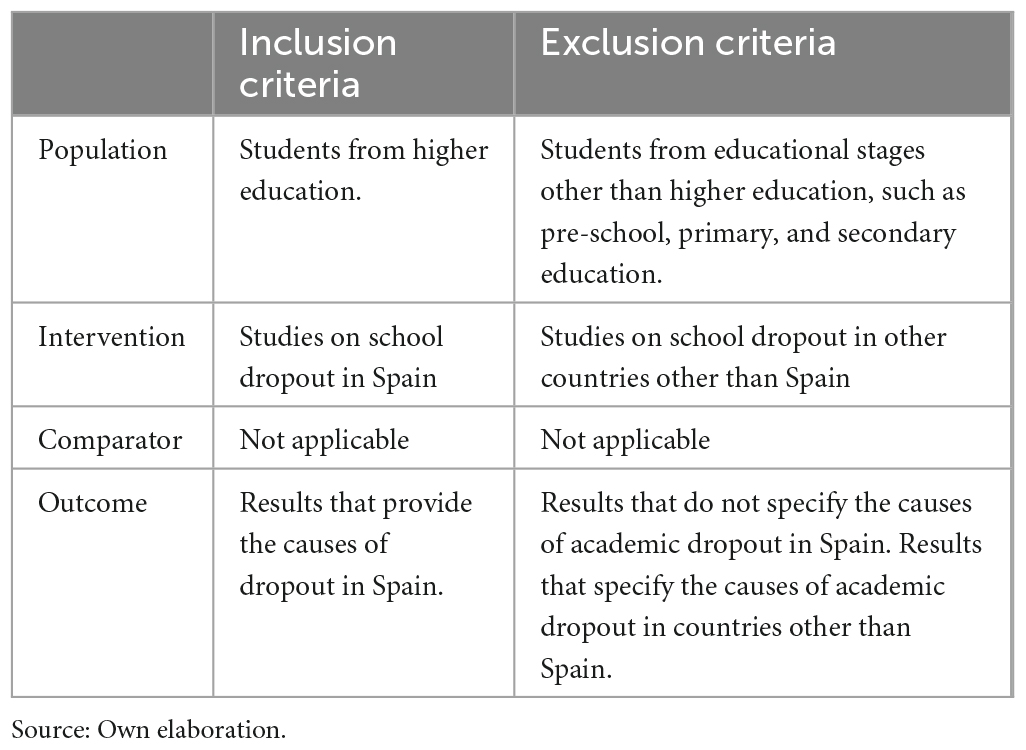
Table 3. Inclusion and exclusion criteria according to patient, intervention, comparison, and outcome (PICO) approach.

Figure 1. Flow chart. Source: Own elaboration based on Moher et al. (2009).
3.2. Eligibility criteria
The search equation was formulated on the basis of the key concepts guiding the study: “dropout” and “higher education.” In order to limit the number of results (1,487) the construct “causes” was included as a descriptor. The terms were translated into English, finally establishing the equation: Academic AND dropout AND higher AND education AND causes.
The search was conducted in the Web of Science (WoS) and Scopus databases, as these databases respond to the impact indexes [Journal Citation Reports (JCR) and Scimago Journal & Country Rank (SJR)] and the indexing of scientific articles in peer-reviewed journals that have undergone a rigorous process for inclusion in WoS and Scopus (Hinojo-Lucena et al., 2019). Inclusion and exclusion criteria can be found in Tables 2, 3, in the latter according to the patient, intervention, comparison, and outcome (PICO) approach (Higgins et al., 2019).
3.3. Review process and establishment of the sample
As mentioned above, the search strategy was carried out in two important databases: WoS and Scopus, considering the quality of the articles indexed in them and their broad scope. After selecting the descriptors that best defined the object of this study and indexing them in Eric’s thesaurus, to ensure that they coincided with the keywords most commonly used in scientific language, we proceeded to perform different search equations (Tables 4, 5).
3.4. Data collection and analysis
At the end of October 2022, a search of scientific literature was carried out in two databases (Scopus and WoS). The search in WoS was not restricted to any specific field since, subsequently, we specified the area to which each article belonged and checked which were the most prolific. The keywords were checked to ensure that they appeared in the title, in the abstract or in the keywords of each article.
Two authors (JJVM and MNCS) conducted separate searches, reviewed the titles, abstracts and keywords of the articles to select those that met the inclusion criteria. Subsequently, duplicate articles were discarded and all selected papers were read in full. A third author (JCdlCC) performed Cohen’s Kappa (Cohen, 1988) to measure the concordance between evaluators, obtaining the value Kappa = 0.70; in addition, he verified that the inclusion and exclusion criteria had been faithfully followed in the article selection process.
To verify the inclusion requirements, Microsoft Excel ad hoc (Microsoft Corporation, Redmond, WA, USA) was used following the premises of the data extraction template of the Cochrane Consumers and Communication Review Group (2016). The authors (MNCS and JAMD) performed this work separately, clarifying in the discussion the results obtained by each and recording the articles and the reasons for exclusion. The tables and graphs present throughout the document, to facilitate understanding of the results, have been edited using Microsoft Word.
Data collection followed the PRISMA statement, dividing the discrimination process into four stages (Figure 1): an initial identification stage, which contained all the articles found in the databases analyzed by applying the search equation in the two previous tables (Tables 4, 5), a second selection stage, in which duplicate references and those matching the exclusion criteria (EX1 and EX2) indicated in Table 2 were eliminated, a third suitability stage, in which the documents were analyzed to extract those that responded to the research objectives and questions and those that met the inclusion criteria (IN3) discarding the rest (EX3), and fourth, in the inclusion stage, the articles that made up the sample for this research were collected. This search was carried out at the end of October 2022, including all articles indexed in the WoS and Scopus databases from 2010 onward.
Statistical Package for the Social Sciences (SPSS) statistical software version 27 was used for data analysis. The tables and figures presented were edited in Microsoft Word to facilitate the understanding of the results.
4. Results
4.1. RQ1: How many studies have been published since 2010 on academic dropout in higher education in Spain and in Andalusia?
A total of 192 papers have been published related to the topic in question, 53 in Scopus and 139 in WoS. After removing duplicate citations, the number of records was 170, as 22 papers were published in both databases. Applying the inclusion criteria IN1 (Journal articles) and IN2 (Articles published from 2010 onward) we found that 120 articles were published from 2010 onward.
Of the 53 documents indexed in the Scopus database, 34 are Articles, 11 are Conference Papers, four are Book Chapters, three are Reviews and one is a Letter. After applying the exclusion and inclusion criteria to the papers and obtaining 31 articles, it can be seen that one article was published in each year in 2011, 2013, 2014, 2016, and 2017. Two articles were published in 2015, three in 2018, four in 2022, five in 2019, six in 2020, and six in 2021. The highest percentage was published in 2020 and 2021, 38.77% of the total (six articles each year), decreasing to 12.90% in the current year (four articles) (Figure 2). Prior to 2010, four articles were published: in 1985, 2004, 2005, and 2008.
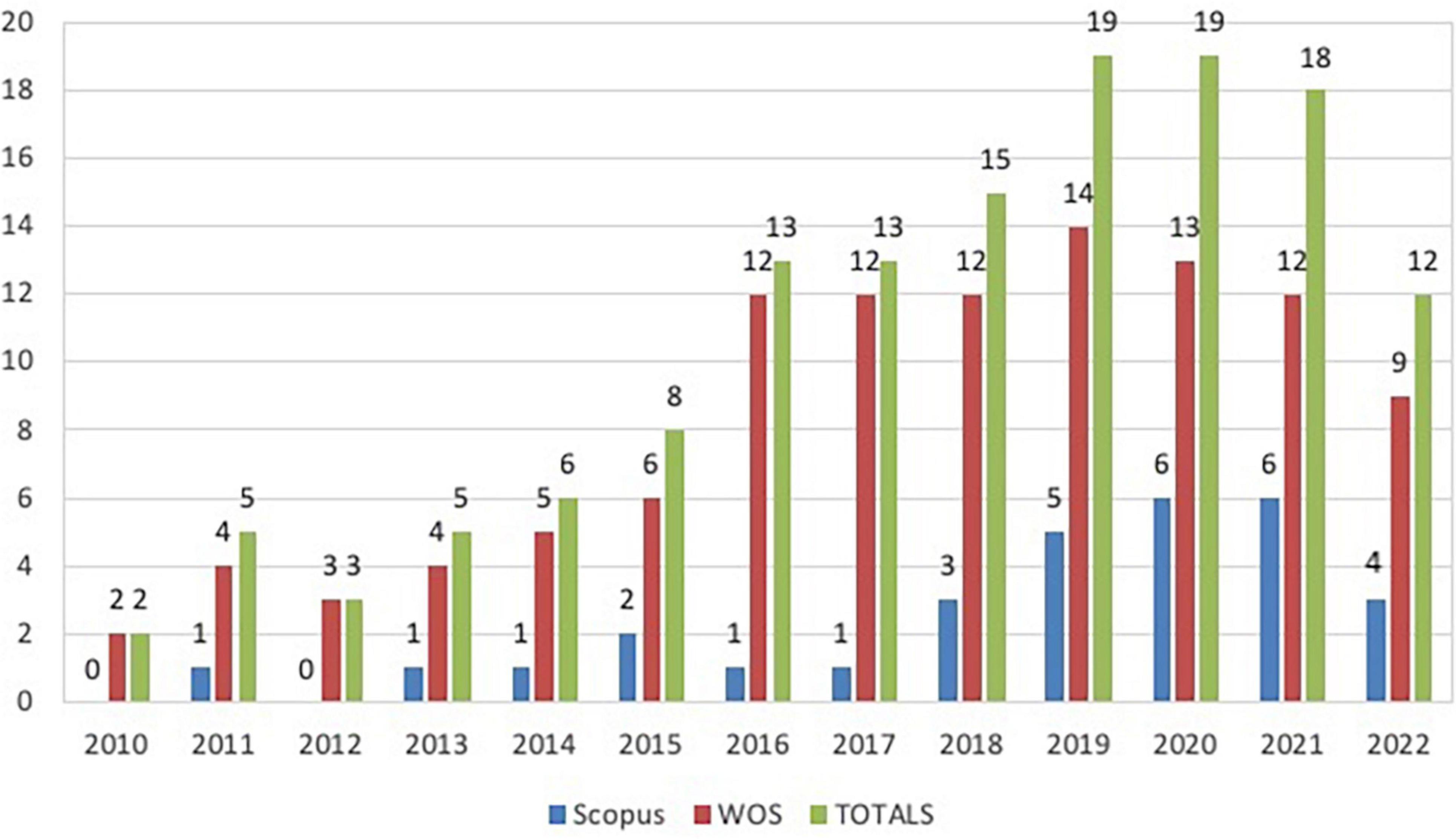
Figure 2. Articles published in the last 12 years in Scopus and Web of Science on the causes of academic dropout in higher education in Spain. Source: Own elaboration.
In the WoS database, 139 documents are indexed. Of these, 116 are articles, 20 are meetings and three are review articles. After applying the exclusion and inclusion criteria to the documents and obtaining 108 articles, it can be seen that two correspond to 2010; four to 2011; three to 2012; four to 2013; five to 2014; six to 2015; 12 each to 2016, 2017, 2018, and 2021; 14 to 2019, 13 to 2020 and nine to 2022. In 2019, the highest percentage was published, 12.96% of the total (14 articles), followed by 2020 with 12.03% (13 articles) decreasing in the following years to nine articles in 2022 (Figure 2). Before 2010, eight articles were published in total, corresponding to the years: 2008, 2007, 2005, 1999, 1994, 1993, 1981, and 1965.
This systematic review comprises a total of 18 articles that met the objectives and inclusion criteria of this research. Three correspond to research carried out in Andalusia: two at the University of Granada and one at the University of Seville.
4.2. RQ2: Which institutions have undertaken research on academic dropout in higher education? RQ3: In which fields of knowledge are the studies on this subject framed? RQ4: What are the causes of academic dropout in higher education in Spain and, specifically, in Andalusia?
This section presents the 18 articles included in this systematic review (Table 6, in which we have specified: reference, university, field of research and causes). As can be seen, the first 13 articles correspond to universities across Spain (Figure 3), in general, and the last four to universities in Andalusia (Figure 4), specifically, four are research works carried out by the University of Granada and one by the University of Seville.
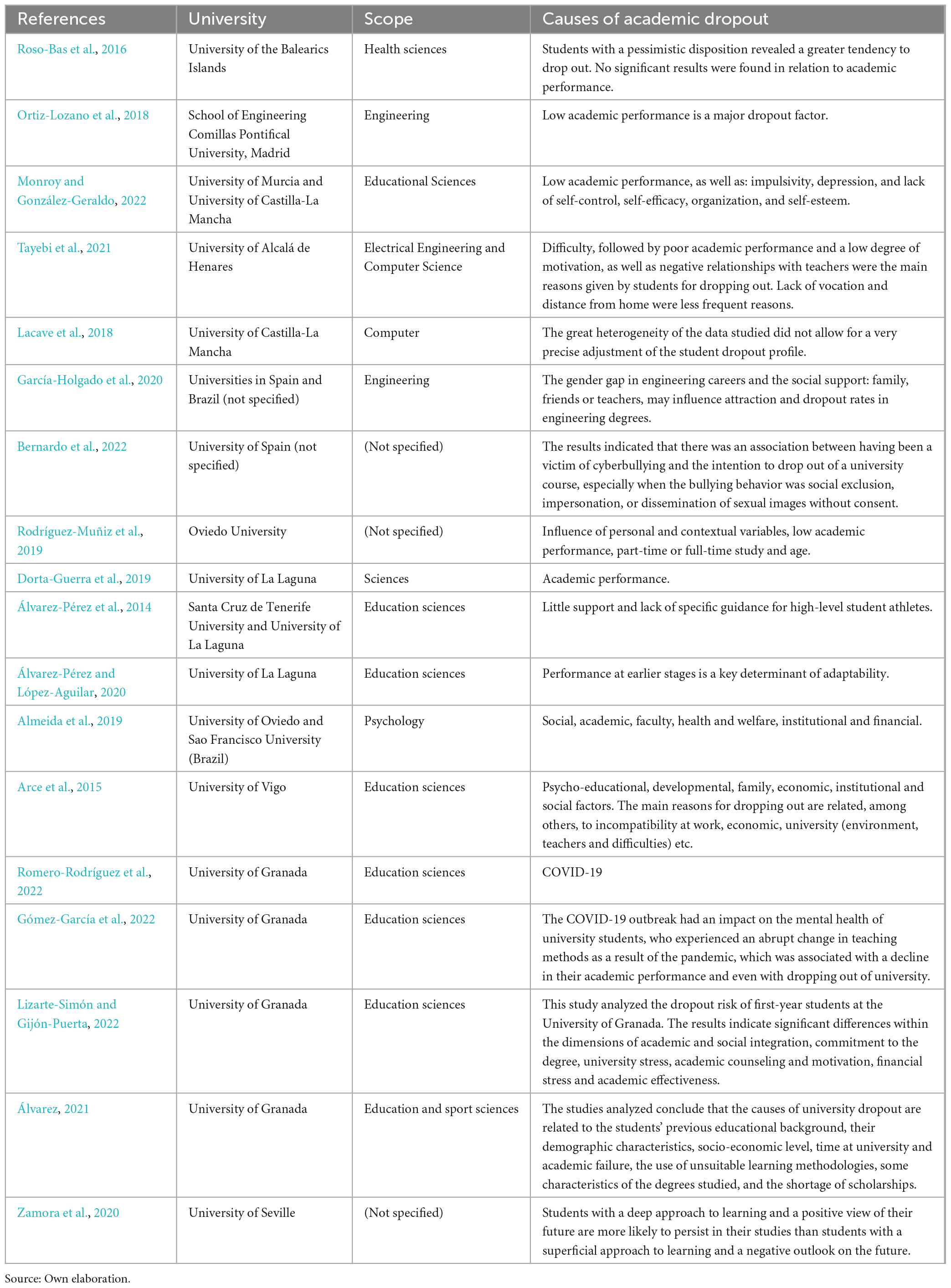
Table 6. Articles addressing the causes of academic dropout in higher education in Spain and, specifically, in Andalusia.
Figure 3 shows that the main cause of academic dropout in Spain is academic performance, followed by social support, socio-economic status, lack of motivation and negative relationships with teachers, which contrast with the causes of academic dropout in Andalusia, which are low academic performance, COVID-19, learning methodologies and demographic characteristics. This significant presence of COVID-19 as a factor of academic dropout in Andalusia may be due to the fact that the research carried out in this Autonomous Community was conducted during or just after the pandemic while most of the Spain studies were conducted prior to the pandemic.
4.3. RQ5: What proposals can be considered to alleviate this situation?
Three articles were found on proposals for the prevention of academic dropout in higher education, two from the University of Granada and one from the Autonomous University of Barcelona (Tables 6, 7).
5. Discussion
The Spanish University System in the academic year 2020–2021 was composed of 84 universities: 50 public and 34 privates. Of these, 21 (25%) have published studies related to academic dropout and are included in this review, with the University of Oviedo, the University of La Laguna, the University of Alcalá de Henares and the University of Granada standing out for their scientific production with between two and three published works. This low production rate may indicate that the problem of academic dropout seems not to have required the research attention of most Spanish universities, despite the fact that this problem affected 21.3% of first-year students in the academic year 2021–2022 (Ministerio de Universidades, 2022). This is the highest rate in Western countries. In the United States, the drop-out rate at the beginning of the second year is 6.2%, although more than 30% of US students do not obtain their degree 3 years after the legal duration of studies. In Finland the drop-out rate is 7.9 and 8.1% in the UK. The Spanish rate is only similar to that of the French-speaking Community of Belgium (21.1%) (Aina et al., 2022).
The dropout rate in Spanish universities as a whole is 33% if all years of study are considered, while in private universities this rate is much higher, with 62.1% of students dropping out of the degrees in which they enroll and more than half of those enrolled (51.5%) not completing any type of university studies (Ministerio de Universidades, 2022). According to Aina et al. (2022) the proportion of students who do not complete a degree programme (in the theoretical duration of plus 3 years) ranges from less than 20% in the UK, Israel, Switzerland, and Ireland to more than 40% in Brazil, Slovenia, Chile, Belgium (French Community), Sweden, Italy, Austria, and Estonia.
In the studies analyzed, the most decisive variable in terms of permanence or dropout, in both Spanish and Andalusian universities, was low academic performance. This is in line with other research (Hailikari et al., 2008; Diseth, 2011; Cerezo et al., 2015; Casanova et al., 2018). Academic performance during the first year reflects the academic competences students have when they start university studies or develop during their first year, their levels of engagement and their learning strategies, which could suggest that less successful students have a less well-defined vocational background or the educational pathway that has led them to higher education is not sufficiently grounded (Belloc et al., 2011; Vries et al., 2011). Given the high level of academic dropout, it is necessary to address the different intervening factors through research aimed at determining prior education, the usefulness of university guidance, learning strategies and communication skills.
Lack of social support is the second cause of dropout. Accordingly, in our opinion, interventions to reduce university dropout should encompass, among other factors, helping students to access family support and to develop personal connections at university to compensate for the absence of family support, as well as academically focused support for students who do not have a strong entry qualification (Sosu and Pheunpha, 2019). In the same vein, Rovira and Bertrán (2018) concluded that university dropout can be minimized through family support, but they also stress the need for university students to be rooted in social capital emanating from the peer group, to have enjoyed positive school experiences and to be boosted by intra-ethnic associationism.
While Arco-Tirado et al. (2011) propose tutoring sessions on planning and time management, together with cognitive and metacognitive learning strategies, motivational strategies and the use of designed materials, Gómez-Salazar and Álvarez Gil (2020) stress the need to anticipate the university stage by offering collaborative workshops between secondary schools and university centers at the pre-university stage to raise student awareness of the curricula, professional opportunities, skills needed to carry out the studies and those that will be achieved upon completion of their degree program.
While present, socio-economic reasons or insufficient scholarships are not the most significant causes of university dropout in Spain or Andalusia (Álvarez, 2021). These factors are very different between countries and national cultures, which influence educational institutions and practices in many ways. It therefore seems reasonable to assume that university dropout is also influenced by differences in national cultures and different levels of economic support (Troelsen and Laursen, 2014). The evidence from the studies reviewed in this article shows that obtaining more scholarships does not reduce the dropout rate and that, in Spain, significant socio-economic gaps do not appear to be a cause of dropout. From a negative social inheritance perspective, this means that students at socio-economic risk in Spain and Andalusia may drop out for exactly the same reasons as the average student. Therefore, the university education system, with its universalistic welfare intentions, seems to work.
6. Conclusion
Although the dropout rate from university studies in Spain is around 21% (for first-year students) and is the highest among its neighboring countries, research on this issue is lacking, with only 25% of Spanish universities having carried out research on this subject in the last 12 years. The studies analyzed in this review conclude that the causes of university dropout are associated with low academic performance, poor social support in the new academic environment, low socio-economic level, pessimism and lack of motivation, together with other less significant factors such as poor relationships with teachers, lack of vocation, work incompatibility, and previous academic performance, among the most frequently mentioned.
Despite the efforts of the researchers, the main limitations of this work have been found in the search for empirical evidence, as little scientific production has been detected to evaluate the results from a correlational statistical point of view that would allow the authors to analyze the relationship between the key words and their implication in the identified axes (as we have mentioned, only 25% of Spanish universities have carried out research on this subject in the last 12 years). Therefore, it has been difficult to contextualize research on university dropout in Spain and, specifically, in the Autonomous Community of Andalusia, hence the relevance of our study.
The theoretical basis of each of the studies analyzed, the methods described, the universities and the students studied have in turn been very varied and therefore very complex, so another limitation was to synthesize the information. Despite the limitations, the usefulness of the findings may be significant at the higher education level, which could be useful for universities to develop programmes to prevent university dropout.
However, it is important to note that these statistics are simply average relative figures and do not show the heterogeneous components between institutions within the Spanish higher education system (i.e., different dropout rates according to the field of study, university facilities, admission rules, etc.) or within the same autonomous community.
Thus, the clearest line of future research would be to address university dropout, either in all the universities of the Andalusian Autonomous Community or at the national level, in order to obtain conclusions that would allow us to establish correlations between the different causes, territories or universities and, therefore, to find out how widespread this phenomenon is in the different Spanish autonomous communities.
Our study concludes that further research is needed on the causes of university dropout and its prevention through family support, anchoring students in their social roots, promoting positive academic experiences, encouraging associations among peers and, within the university, carrying out activities (such as workshops and seminars) to improve planning and time management, together with cognitive learning strategies, motivational strategies and the use of advanced learning materials [such as Information and Communication Technology (ICT) tools]. In addition, prior to starting university, secondary school students should be made aware of the curricula, career opportunities, skills needed to pursue the studies and the competences to be achieved upon completion of their studies.
Data availability statement
The datasets generated and analyzed during the current study are available from the corresponding author on reasonable request.
Author contributions
J-CC-C, M-NC-S, J-AM-D, and J-JV-M contributed to conception and design of the study. M-NC-S organized the database and performed the review. J-JV-M wrote the first draft of the manuscript. J-CC-C and J-AM-D wrote sections of the manuscript. All authors contributed to manuscript revision and read and approved the submitted version.
Acknowledgments
The authors thank Maria Repice for revising the English version of the manuscript.
Conflict of interest
The authors declare that the research was conducted in the absence of any commercial or financial relationships that could be construed as a potential conflict of interest.
Publisher’s note
All claims expressed in this article are solely those of the authors and do not necessarily represent those of their affiliated organizations, or those of the publisher, the editors and the reviewers. Any product that may be evaluated in this article, or claim that may be made by its manufacturer, is not guaranteed or endorsed by the publisher.
References
Acevedo, F. (2020). Factores explicativos del abandono de los estudios en la educación superior en contextos socio-académicos desfavorables. Rev. Esp. Pedag. 78, 253–270. doi: 10.22550/rep78-2-2020-02
Aina, C., Baici, E., Casalone, G., and Pastore, F. (2018). The economics of university dropouts and delayed graduation: A survey. SSRN Electron. J. doi: 10.2139/ssrn.3153385
Aina, C., Baici, E., Casalone, G., and Pastore, F. (2022). The determinants of university dropout: A review of the socio-economic literature. Socio Econ. Plann. Sci. 79:101102. doi: 10.1016/j.seps.2021.101102
Almeida, L. S., Casanova, J. R., Bernardo, A. B., Cervero, A., dos Santos, A. A. A., and Ambiel, R. A. (2019). Construção de um questionário transcultural de motivos de abandono do ensino superior. Rev. Avaliação Psicol. 18, 201–209. doi: 10.15689/ap.2019.1802.17694.11
Alonso, P., and Lobato, H. (2005). Elementos que influyen en el fracaso universitario: Un estudio descriptivo. REOP Rev. Esp. Orientac. Psicopedagogía 16, 63–79. doi: 10.5944/reop.vol.16.num.1.2005.11363
Álvarez, D. (2021). Análisis del abandono universitario en España: Un estudio bibliométrico. Publicaciones 51, 241–261. doi: 10.30827/publicaciones.v51i2.23843
Álvarez-Pérez, P. R., Pérez, P. R. Á, Jorge, D. P., Ramallal, M. E. G., and Aguilar, D. L. (2014). Los estudios universitarios de hombres y mujeres deportistas de alto nivel: Un análisis sobre la difícil relación entre estudios y deporte. RETOS Nuevas Tendencias Educ. Física Deporte Recreación 26, 94–100.
Álvarez-Pérez, P.-R., and López-Aguilar, D. (2020). Competencias de adaptabilidad y factores de éxito académico del alumnado universitario. Rev. Iberoam. Educ. Super. 11, 46–66. doi: 10.22201/iisue.20072872e.2020.32.815
Arce, M. E., Crespo, B., and Míguez-Álvarez, C. (2015). Higher education drop-out in Spain—particular case of universities in Galicia. Int. Educ. Stud. 8, 247–264. doi: 10.5539/ies.v8n5p247
Arco-Tirado, J. L., Fernández-Martín, F. D., and Fernández-Balboa, J.-M. (2011). The impact of a peer-tutoring program on quality standards in higher education. High. Educ. 62, 773–788. doi: 10.1007/s10734-011-9419-x
Belloc, F., Maruotti, A., and Petrella, L. (2011). How individual characteristics affect university students drop-out: A semiparametric mixed-effects model for an Italian case study. J. Appl. Stat. 38, 2225–2239. doi: 10.1080/02664763.2010.545373
Bernardo, A. B., Galve-González, C., Cervero, A., and Tuero, E. (2022). Cyberbullying in first-year university students and its influence on their intentions to drop out. High. Educ. Res. Dev. 1–15. doi: 10.1080/07294360.2022.2057447
Cabrera, L., Bethencourt, J. T., González, M. C., and Álvarez-Pérez, P. R. (2006). Un estudio transversal retrospectivo sobre prolongación y abandono de estudios universitarios. RELIEVE Rev. Electrón. Investig. Eval. Educ. 12. doi: 10.7203/relieve.12.1.4241
Casanova, J. R., Cervero Fernández-Castañón, A., Núñez Pérez, J. C., Almeida, L. S., and Bernardo Gutiérrez, A. B. (2018). Factors that determine the persistence and dropout of university students. Psicothema 30, 408–414. doi: 10.7334/psicothema2018.155
Cervero, A., Bernardo, A., Esteban, M., Tuero, E., Carbajal, R., and Núñez, J. C. (2017). ‘Influencia en el abandono universitario de variables relacionales y sociales’, Revista de Estudios e Investigación en Psicología y Educación, 12, 46–49. doi: 10.17979/reipe.2017.0.12.2531
Cerezo, R., Bernardo, A., Esteban, M., Sánchez, M., and Tuero, E. (2015). Programas para la promoción de la autorregulación en educación superior: Un estudio de la satisfacción diferencial entre metodología presencial y virtual. Eur. J. Educ. Psychol. 8, 30–36. doi: 10.1016/j.ejeps.2015.10.004
Clavijo-Cáceres, D., and Balaguera-Rodríguez, A. Y. (2020). La calidad y la docencia universitaria: Algunos criterios para su valoración. Rev. Investig. Desarro. Innov. 11, 127–139. doi: 10.19053/20278306.v11.n1.2020.11688
Cochrane Consumers and Communication Review Group (2016). Data extraction template for included studies. Available online at: https://cccrg.cochrane.org/sites/cccrg.cochrane.org/files/public/uploads/det_2015_revised_final_june_20_2016_nov_29_revised.doc (accessed October 26, 2022).
Cohen, J. (1988). Análisis de poder estadístico para las ciencias del comportamiento, 2a Edn. Hillsdale, NJ: Lawrence Erlbaum Associates.
Diseth, Å. (2011). Self-efficacy, goal orientations and learning strategies as mediators between preceding and subsequent academic achievement. Learn. Individ. Dif. 21, 191–195. doi: 10.1016/j.lindif.2011.01.003
Dorta-Guerra, R., Marrero, I., Abdul-Jalbar, B., Trujillo-González, R., and Torres, N. V. (2019). A new academic performance indicator for the first term of first-year science degrees students at La Laguna University: A predictive model. FEBS Open Bio 9, 1493–1502. doi: 10.1002/2211-5463.12707
European Commission, Directorate-General for Education, Youth, Sport and Culture, Wollscheid, S., Stensaker, B., and Jongbloed, B. (2015). Dropout and completion in higher education in Europe: Main report. Publications Office. Available online at: https://data.europa.eu/doi/10.2766/826962 (accessed October 26, 2022).
Eurostat’s (2018). Work beats study for 25% of university drop-outs. Available online at: https://ec.europa.eu/eurostat/en/web/products-eurostat-news/-/ddn-20180404-1 (accessed February 6, 2023).
Fernández-Mellizo, M. (2022). Análisis del abandono de los estudiantes de grado en las universidades presenciales en España. Madrid: Programa Editorial del Ministerio de Universidades.
García-Holgado, A., Gonzalez-Gonzalez, C. S., and Peixoto, A. (2020). A comparative study on the support in engineering courses: A case study in Brazil and Spain. IEEE Access Pract. Innov. Open Solut. 8, 125179–125190. doi: 10.1109/access.2020.3007711
García-Peñalvo, F. J. (2019). “Metodología de revisión sistemática de literatura,” in Presentado en la facultad psicología de la pontificia universidad católica del perú (7 de octubre de 2022), Salamanca. doi: 10.5281/ZENODO.3249429
Gómez-García, G., Ramos-Navas-Parejo, M., de la Cruz-Campos, J.-C., and Rodríguez-Jiménez, C. (2022). Impact of COVID-19 on university students: An analysis of its influence on psychological and academic factors. Int. J. Environ. Res. Public Health 19:10433. doi: 10.3390/ijerph191610433
Gómez-Salazar, N. N., and Álvarez Gil, A. (2020). El papel de la universidad frente al abandono de estudios. Formación pre-universitaria basada en talleres de innovación y creatividad. Innoeduca Int. J. Technol. Educ. Innov. 6, 66–72. doi: 10.24310/innoeduca.2020.v6i1.4412
Hailikari, T., Nevgi, A., and Komulainen, E. (2008). Academic self-beliefs and prior knowledge as predictors of student achievement in Mathematics: A structural model. Educ. Psychol. 28, 59–71. doi: 10.1080/01443410701413753
Higgins, J. P., Thomas, J., Chandler, J., Cumpston, M., Li, T., Page, M. J., et al. (2019). Cochrane handbook for systematic reviews of interventions. Hoboken, NJ: Wiley-Blackwell.
Hinojo-Lucena, F. J., Aznar Díaz, I., Romero Rodríguez, J. M., and Marín Marín, J. A. (2019). Influencia del aula invertida en el rendimiento académico. Una revisión sistemática. Campus Virtuales 8, 9–18.
Joulaei, H., and Kalateh-Sadati, A. (2020). COVID-19 outbreak and school dropout; A worldwide challenge for an equitable future. Int. J. Sch. Health 7, 1–2. doi: 10.30476/intjsh.2020.88876.1117
Lacave, C., Molina, A. I., and Cruz-Lemus, J. A. (2018). Learning analytics to identify dropout factors of computer science studies through bayesian networks. Behav. Inf. Technol. 37, 993–1007. doi: 10.1080/0144929x.2018.1485053
Lara-García, B., González-Palacios, A., González-Álvarez, M., and Martínez-González, M. G. (2014). Fracaso escolar: Conceptualización y perspectivas de estudio. Rev. Educ. Desarro. 30, 71–83.
Lizarte-Simón, E. J., and Gijón-Puerta, J. (2022). Prediction of early dropout in higher education using the SCPQ. Cogent Psychol. 9:2123588.
López-Martínez, M., Reverte, G. M., and Palacios, M. Ma. (2016). El fracaso escolar en España y sus regiones: Disparidades territoriales. Rev. Estud. Reg. 107, 121–155.
Martínez, J. S., and Molina Derteano, P. (2019). Fracaso escolar, crisis económica y desigualdad de oportunidades educativas: España y Argentina. Papers 104:279. doi: 10.5565/rev/papers.2574
Ministerio de Universidades (2021). Estadística de estudiantes. Available online at: https://www.universidades.gob.es/estadistica-de-estudiantes/ (accessed October 15, 2022).
Ministerio de Universidades (2022). Datos y cifras del Sistema Universitario Español.Publicación 2021-2022. Available online at: https://www.universidades.gob.es/wp-content/uploads/2022/11/Datos_y_Cifras_2021_22.pdf (accessed October 15, 2022).
Moher, D., Altman, D. G., Liberati, A., and Tetzlaff, J. (2009). Preferred reporting items for systematic reviews and meta-analyses: The PRISMA statement. PLoS Med. 6:e1000097. doi: 10.1371/journal.pmed.1000097
Monroy, F., and González-Geraldo, J. L. (2022). Development of a procrastination scale in Spanish and measurement of education students’ procrastination levels. Bordón Rev. Pedag. 74, 63–76. doi: 10.13042/bordon.2022.93054
Noriega, G., and Arjona, B. A. (2011). El fracaso escolar universitario. Perspect. Docentes 47, 39–46.
OECD (2017). Education at a Glance: OECD Indicators. Paris: OECD Publishing. doi: 10.1787/eag-2017-en
Ortiz-Lozano, J. M., Rua-Vieites, A., Bilbao-Calabuig, P., and Casadesús-Fa, M. (2018). University student retention: Best time and data to identify undergraduate students at risk of dropout. Innov. Educ. Teach. Int. 57, 74–85. doi: 10.1080/14703297.2018.1502090
Pertegal-Felices, M. L., Valdivieso-Salazar, D. A., Espín-León, A., and Jimeno-Morenilla, A. (2022). Resiliencia y abandono académico en estudiantes universitarios ecuatorianos durante el COVID-19. Sustainability 14:8066. doi: 10.3390/su14138066
Pompa, ÁL., Ponz, N., Rama, V., and Ríos González, J. A. (2003). Fracaso universitario: ¿ilusión o realidad? REOP Rev. Esp. Orientac. Psicopedagogía 14:81. doi: 10.5944/reop.vol.14.num.2.2003.11613
Portal, E., Arias, E., Lirio, J., and Gómez, J. L. (2022). Fracaso y abandono universitario: Percepción de los(as) estudiantes de Educación social de la Universidad de Castilla La Mancha. Rev. Mex. Investig. Educ. 27, 289–316.
Real, M. R. (2011). El liderazgo de los centros educativos y las buenas prácticas ante el fracaso escolar y la exclusión social en la comunidad autónoma de Andalucía. Rev. Investig. Educ. 9, 157–167.
Rodríguez-Muñiz, L. J., Bernardo, A. B., Esteban, M., and Díaz, I. (2019). Dropout and transfer paths: What are the risky profiles when analyzing university persistence with machine learning techniques? PLoS One 14:e0218796. doi: 10.1371/journal.pone.0218796
Romero-Rodríguez, J.-M., Hinojo Lucena, F. J., Aznar Díaz, I., and Gómez García, G. (2022). Digitalización de la Universidad por Covid-19: Impacto en el aprendizaje y factores psicosociales de los estudiantes. RIED Rev. Iberoam. Educ. Distancia 25, 153–172. doi: 10.5944/ried.25.2.32660
Romero-Rodríguez, J.-M., Ramírez-Montoya, M. S., Aznar-Díaz, I., and Hinojo-Lucena, F. J. (2020). Social appropriation of knowledge as a key factor for local development and open innovation: A systematic review. J. Open Innov. Technol. Mark. Complex. 6:44. doi: 10.3390/joitmc6020044
Roso-Bas, F., Pades, A., and García-Buades, E. (2016). Emotional variables, dropout and academic performance in Spanish nursing students. Nurse Educ. Today 37, 53–58. doi: 10.1016/j.nedt.2015.11.021
Rovira, J. P., and Bertrán, M. (2018). Factors afecting educational success and continuity among Young people of Moroccan descent in Catalonia (Spain). IJERI Int. J. Educ. Res. Innov. 10, 179–189.
Ruiz-Corbella, M., and López-Gómez, E. (2019). La misión de la universidad en el siglo XXI: Comprender su origen para proyectar su futuro. Rev. Educ. Super. 48, 1–19. doi: 10.36857/resu.2019.189.612
Sánchez-Meca, J. (2010). Cómo realizar una revisión sistemática y un meta-análisis. Aula Abierta 38, 53–64.
Sosu, E. M., and Pheunpha, P. (2019). Trajectory of university dropout: Investigating the cumulative effect of academic vulnerability and proximity to family support. Front. Educ. 4:6. doi: 10.3389/feduc.2019.00006
Tayebi, A., Gomez, J., and Delgado, C. (2021). Analysis on the lack of motivation and dropout in engineering students in Spain. IEEE Access Pract. Innov. Open Solut. 9, 66253–66265. doi: 10.1109/access.2021.3076751
Torres, A. E., Brito-Cruz, T., del, J., Pérez-Jaimes, A. K., and Lara Gamboa, C. C. (2021). Reprobación escolar: La percepción del estudiante universitario. Educateconciencia 29, 77–93.
Troelsen, R., and Laursen, P. F. (2014). Is drop-out from university dependent on national culture and policy? The case of Denmark: Is dropout from university dependent on national culture and policy? Eur. J. Educ. 49, 484–496. doi: 10.1111/ejed.12094
Vries, W. D., León Arenas, P., Romero Muñoz, J. F., and Hernández Saldaña, I. (2011). ¿Desertores o decepcionados? Distintas causas para abandonar los estudios universitarios. Rev. Educ. Super. 40, 29–49.
Keywords: academic dropout, higher education, dropout prevention, COVID-19, Andalusia
Citation: de la Cruz-Campos J-C, Victoria-Maldonado J-J, Martínez-Domingo J-A and Campos-Soto M-N (2023) Causes of academic dropout in higher education in Andalusia and proposals for its prevention at university: A systematic review. Front. Educ. 8:1130952. doi: 10.3389/feduc.2023.1130952
Received: 24 December 2022; Accepted: 16 February 2023;
Published: 07 March 2023.
Edited by:
Antonio Hernandez Fernandez, University of Jaén, SpainReviewed by:
María del Mar Simón Márquez, University of Almería, SpainAnthony Picciano, Hunter College (CUNY), United States
Copyright © 2023 de la Cruz-Campos, Victoria-Maldonado, Martínez-Domingo and Campos-Soto. This is an open-access article distributed under the terms of the Creative Commons Attribution License (CC BY). The use, distribution or reproduction in other forums is permitted, provided the original author(s) and the copyright owner(s) are credited and that the original publication in this journal is cited, in accordance with accepted academic practice. No use, distribution or reproduction is permitted which does not comply with these terms.
*Correspondence: Juan-Carlos de la Cruz-Campos, juancarlosdelacruz@ugr.es
 Juan-Carlos de la Cruz-Campos
Juan-Carlos de la Cruz-Campos Juan-José Victoria-Maldonado
Juan-José Victoria-Maldonado José-Antonio Martínez-Domingo
José-Antonio Martínez-Domingo María-Natalia Campos-Soto
María-Natalia Campos-Soto